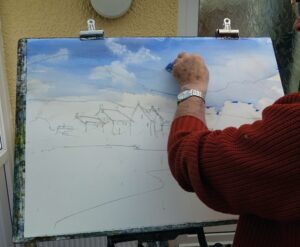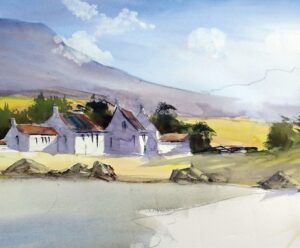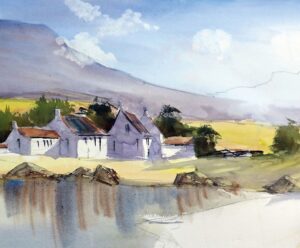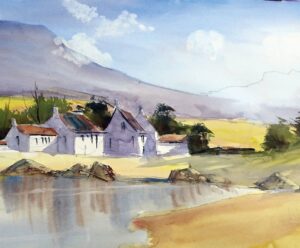
Arnold Lowrey paints a watercolour landscape, using only his mind’s eye. Here he shares how he did it.
Cobalt Blue, Ultramarine Blue, Cadmium Yellow Medium, Lemon Yellow, Burnt Umber, Vermilion Hue, Quinacridone Rose
SAA Silver Landscape Brush Set
Bockingford 300gsm Block 16″ x 12″ (31 x 41cm) NOT
Kitchen roll
Art is not about photographic likenesses. It is about painting shapes of tone and colour with imagination and skill.
I decided to paint a landscape of an area known as Yerwol. This is actually my surname spelt backwards and means my painting is completely made up! I included some mountains, trees and a cottage as the focal point, surrounded by a great, crisp winter sky. The foreground consisted of a river, including some reflections of the cottage, with the nearside bank containing some plant life and a figure.
1. I started by drawing out the scene, making sure the focal point is not in the centre of the picture. About a third from two sides will be ideal. 
2. Once I was happy with the composition, I wetted the sky area, mixed some Cobalt Blue on my palette – note: this has a flat mixing area – then, using a Flat brush, I wetted it, wrung out the water, then picked up the paint with one sweep. The paint will even itself in the brush and allow the applied paint to stay with softened edges and run all over the area. Then, using some kitchen roll, I dabbed out the clouds.
3. Next, I painted in the mountains with Cobalt Blue and Ultramarine Blue, then the fields directly below using Lemon Yellow. This was followed by painting the trees around the cottage with mixtures of Ultramarine Blue, Cadmium Yellow, Lemon Yellow and Burnt Umber. The roofs were added using Vermillion Hue and Ultramarine Blue.
4. I then decided to add the shadows using a mix of Cobalt Blue and Quinacridone Rose. It is important to first decide where the light is coming from and apply the shadows from the sides facing away from the light. Paint in the rocks at the water’s edge and use a single edged razorblade or old credit card to scrape out the sunlit areas while still wet. Now, wet the area of foreground water and paint in Cobalt Blue, similar to the sky.
5. While still wet – and using the same colours as used in the cottage and trees – pull down the rock’s reflections in the water. Paint in the foreground and add a few grasses.
6. Many paintings can look deserted, so it can help to add a person. This will give a lived-in feeling to your composition. If, however, you are not happy with painting figures, then add smoke coming out of the chimney. This will imply warmth and someone inside, staying cosy while it’s cold outside.
Note: the colours used were based on my decisions. Feel free to use your own.

1. Never, ever put the focal point in the centre. Your pictures will end up looking like stage curtains.
2. Colours that are similar in tonal value are harmonious.
3. Colours that are of different tones will clash
For more information on
Arnold and his work, visit
www.lowrey.co.uk
Email: alowrey@lowrey.co.uk